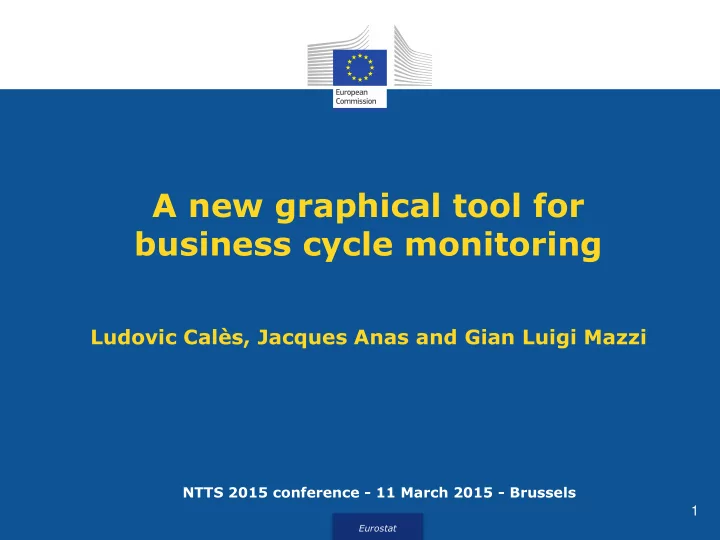

A new graphical tool for business cycle monitoring Ludovic Calès, Jacques Anas and Gian Luigi Mazzi NTTS 2015 conference - 11 March 2015 - Brussels 1 Eurostat
A new Business Cycle Clock The objective of the new Business Cycle Clock is to represent the cyclical situation on a clock based on the αABβCD approach, see [1]. Each peak and trough is located on a clock and the hand location is given by the cyclical indicators currently produced for Eurostat (GCCI, BCCI, ACCI). [1] “Detecting cyclical turning points: the ABCD approach and two probabilistic indicators” by Jacques ANAS and Laurent FERRARA, 26th CIRET Conference 2002 2 Eurostat
The website The web application is composed of 3 elements: • the upper part of the window is dedicated to the graph representation. • the lower left corner of the window is dedicated to the business cycle clock • the lower right corner is used to present cycle statistics. 3 Eurostat
Illustration of the website 4 Eurostat
Remark It is worth noting that the clock and graph representation are dynamic. A play button makes time running. The current position in the graph representation is highlighted and the clock hand runs. 5 Eurostat
Cyclical turning points: the extended α AB β CD approach • The turning point detection issue is considered as a progressive follow-up of the cyclical movement. Even if no cycle is similar to the previous one, the sequence of turning points is always respected in practice. • Deceleration (point α ) will turn into a slowdown movement (point A of the growth cycle) and if it is getting worse, the growth rate will become negative (point B), thus determining a recession. 6 Eurostat
ABCD Approach Business Cycle Cycle des affaires . A . B . . . B and C are the extrema of D C the business cycle . level niveau tendance trend Growth Cycle Cycle de croissance A . A and D are the extrema of the growth cycle (also called 0 deviation cycle) 0 . écart à tendance deviation to trend D period of slow recession phase de ralentissement period of recession phase de récession Growth Rate Cycle Cycle du t aux de croissance . α and β are the extrema of the growth rate Cycle (also called acceleration cycle ) . . 0 . 0 B C instantaneous taux de croissance instantané growth rate 7 Eurostat
Cyclical Indicators The Growth Cycle Coincident Indicator (GCCI) provides the • probability of a slowdown in the economy. Thus it signals the peaks and troughs of the growth cycle. The Business Cycle Coincident Indicator (BCCI) provides • the probability of a recession. Thus it signals the peaks and troughs of the business cycle. The Acceleration Cycle Coincident Indicator (ACCI) • provides the probability of a deceleration in the growth rate. Thus it signals the peaks and troughs of the growth rate cycle. 8 Eurostat
The Clock framework • Noon is α, peak of the growth rate cycle • 3 pm is A, peak of the growth cycle • 4.30 pm is B, peak of the business cycle • 6 pm is β, trough of the growth rate cycle • 7.30 pm is C, trough of the business cycle • 9 pm is D, trough of the growth cycle 9 Eurostat
Relationship with Cyclical Indicators Using the Growth, Business and Acceleration cycles indicators, we compute the location of the hand, associating each clock sector to values of the indicators. ACCI <0.5 >0.5 BCCI BCCI <0.5 >0.5 <0.5 >0.5 <0.5 6 1 GCCI >0.5 5 4 2 3 10 Eurostat
Pure Business Cycle In the first quadrant, the growth rate is still above the trend growth rate In A the growth rate slips below the trend growth rate In the second quadrant, the growth rate is below the trend growth rate In B, it becomes negative In β, the growth rate reaches a minimum 11 Eurostat
Pure Growth Cycle 12 Eurostat
Pure Acceleration Cycle 13 Eurostat
Euro Area recession exit in June 2013 (following a reacceleration in November 2012) 14 Eurostat
Historical representation Beside the Business Cycle Clock, a more didactical representation of the growth cycles is presented. It consists of a graph of the GDP deviations from the trend, where the peaks and troughs of the cycles are highlighted. 15 Eurostat
Historical representation The slowdown phases are represented in pink. • The recession phases are represented in dark pink. • Each point of the αABβCD cycle is represented by a • stick. 16 Eurostat
Comparison among countries • The new business cycle clock can also be used to assess and compare the situations among different countries. For instance, in the following slide, we illustrate the comparison of Germany, France and Italy with the Euro Area. • The new business cycle clock aims at representing up to 4 countries simultaneously. 17 Eurostat
Cross-country comparison in Dec. 2011 18 Eurostat
Thank you! 19 Eurostat
Recommend
More recommend